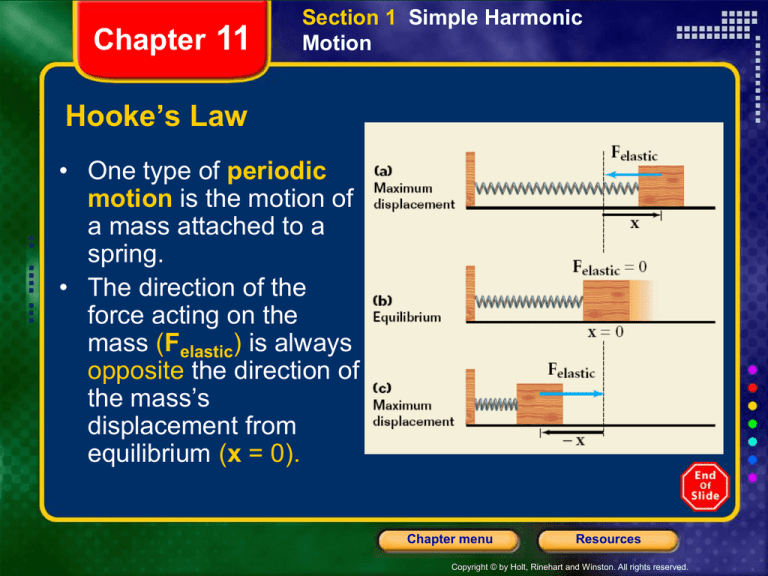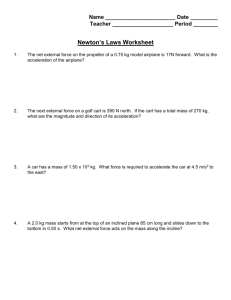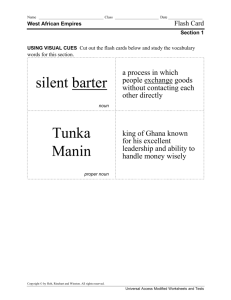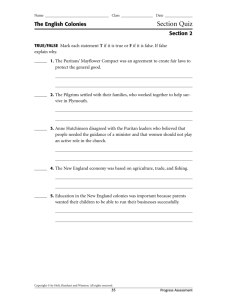
Chapter 11
Section 1 Simple Harmonic
Motion
Hooke’s Law
• One type of periodic
motion is the motion of
a mass attached to a
spring.
• The direction of the
force acting on the
mass (Felastic) is always
opposite the direction of
the mass’s
displacement from
equilibrium (x = 0).
Chapter menu
Resources
Copyright © by Holt, Rinehart and Winston. All rights reserved.
Chapter 11
Section 1 Simple Harmonic
Motion
Hooke’s Law, continued
At equilibrium:
• The spring force and the mass’s acceleration
become zero.
• The speed reaches a maximum.
At maximum displacement:
• The spring force and the mass’s acceleration reach
a maximum.
• The speed becomes zero.
Chapter menu
Resources
Copyright © by Holt, Rinehart and Winston. All rights reserved.
Chapter 11
Section 1 Simple Harmonic
Motion
Hooke’s Law, continued
• Measurements show that the spring force, or
restoring force, is directly proportional to the
displacement of the mass.
• This relationship is known as Hooke’s Law:
Felastic = –kx
spring force = –(spring constant displacement)
• The quantity k is a positive constant called the
spring constant.
Chapter menu
Resources
Copyright © by Holt, Rinehart and Winston. All rights reserved.
Section 1 Simple Harmonic
Motion
Chapter 11
Spring Constant
Click below to watch the Visual Concept.
Visual Concept
Chapter menu
Resources
Copyright © by Holt, Rinehart and Winston. All rights reserved.
Chapter 11
Section 1 Simple Harmonic
Motion
Sample Problem
Hooke’s Law
If a mass of 0.55 kg attached to a vertical spring
stretches the spring 2.0 cm from its original equilibrium
position, what is the spring constant?
Chapter menu
Resources
Copyright © by Holt, Rinehart and Winston. All rights reserved.
Chapter 11
Section 1 Simple Harmonic
Motion
Sample Problem, continued
1. Define
Given:
m = 0.55 kg
x = –2.0 cm = –0.20 m
g = 9.81 m/s2
Diagram:
Unknown:
k=?
Chapter menu
Resources
Copyright © by Holt, Rinehart and Winston. All rights reserved.
Chapter 11
Section 1 Simple Harmonic
Motion
Sample Problem, continued
2. Plan
Choose an equation or situation: When the mass
is attached to the spring,the equilibrium position
changes. At the new equilibrium position, the net
force acting on the mass is zero. So the spring force
(given by Hooke’s law) must be equal and opposite
to the weight of the mass.
Fnet = 0 = Felastic + Fg
Felastic = –kx
Fg = –mg
–kx – mg = 0
Chapter menu
Resources
Copyright © by Holt, Rinehart and Winston. All rights reserved.
Chapter 11
Section 1 Simple Harmonic
Motion
Sample Problem, continued
2. Plan, continued
Rearrange the equation to isolate the unknown:
kx mg 0
kx mg
mg
k
x
Chapter menu
Resources
Copyright © by Holt, Rinehart and Winston. All rights reserved.
Chapter 11
Section 1 Simple Harmonic
Motion
Sample Problem, continued
3. Calculate
Substitute the values into the equation and
solve:
mg
(0.55 kg)(9.81 m/s2 )
k
x
–0.020 m
k 270 N/m
4. Evaluate
The value of k implies that 270 N of force is
required to displace the spring 1 m.
Chapter menu
Resources
Copyright © by Holt, Rinehart and Winston. All rights reserved.
Chapter 11
Section 1 Simple Harmonic
Motion
Simple Harmonic Motion
• The motion of a vibrating mass-spring system is an
example of simple harmonic motion.
• Simple harmonic motion describes any periodic
motion that is the result of a restoring force that is
proportional to displacement.
• Because simple harmonic motion involves a restoring
force, every simple harmonic motion is a backand-forth motion over the same path.
Chapter menu
Resources
Copyright © by Holt, Rinehart and Winston. All rights reserved.
Chapter 11
Section 1 Simple Harmonic
Motion
Simple Harmonic Motion
Click below to watch the Visual Concept.
Visual Concept
Chapter menu
Resources
Copyright © by Holt, Rinehart and Winston. All rights reserved.
Chapter 11
Section 1 Simple Harmonic
Motion
Force and Energy in Simple Harmonic Motion
Click below to watch the Visual Concept.
Visual Concept
Chapter menu
Resources
Copyright © by Holt, Rinehart and Winston. All rights reserved.
Chapter 11
Section 1 Simple Harmonic
Motion
The Simple Pendulum
• A simple pendulum consists of
a mass called a bob, which is
attached to a fixed string.
• At any displacement from
equilibrium, the weight of the
bob (Fg) can be resolved into
two components.
• The x component (Fg,x = Fg sin
q) is the only force acting on the
bob in the direction of its motion
and thus is the restoring force.
The forces acting on the
bob at any point are the
force exerted by the
string and the
gravitational force.
Chapter menu
Resources
Copyright © by Holt, Rinehart and Winston. All rights reserved.
Chapter 11
Section 1 Simple Harmonic
Motion
The Simple Pendulum, continued
• The magnitude of the restoring force
(Fg,x = Fg sin q) is proportional to sin q.
• When the maximum angle of
displacement q is relatively small
(<15°), sin q is approximately equal to
q in radians.
• As a result, the restoring force is very nearly
proportional to the displacement.
• Thus, the pendulum’s motion is an excellent
approximation of simple harmonic motion.
Chapter menu
Resources
Copyright © by Holt, Rinehart and Winston. All rights reserved.
Chapter 11
Section 1 Simple Harmonic
Motion
Restoring Force and Simple Pendulums
Click below to watch the Visual Concept.
Visual Concept
Chapter menu
Resources
Copyright © by Holt, Rinehart and Winston. All rights reserved.
Chapter 11
Section 1 Simple Harmonic
Motion
Simple Harmonic Motion
Chapter menu
Resources
Copyright © by Holt, Rinehart and Winston. All rights reserved.
Chapter 11
Section 2 Measuring Simple
Harmonic Motion
Amplitude, Period, and Frequency in SHM
• In SHM, the maximum displacement from equilibrium
is defined as the amplitude of the vibration.
– A pendulum’s amplitude can be measured by the angle
between the pendulum’s equilibrium position and its
maximum displacement.
– For a mass-spring system, the amplitude is the maximum
amount the spring is stretched or compressed from its
equilibrium position.
• The SI units of amplitude are the radian (rad) and
the meter (m).
Chapter menu
Resources
Copyright © by Holt, Rinehart and Winston. All rights reserved.
Chapter 11
Section 2 Measuring Simple
Harmonic Motion
Amplitude, Period, and Frequency in SHM,
continued
• The period (T) is the time that it takes a complete
cycle to occur.
– The SI unit of period is seconds (s).
• The frequency (f) is the number of cycles or
vibrations per unit of time.
– The SI unit of frequency is hertz (Hz).
– Hz = s–1
Chapter menu
Resources
Copyright © by Holt, Rinehart and Winston. All rights reserved.
Chapter 11
Section 2 Measuring Simple
Harmonic Motion
Amplitude, Period, and Frequency in SHM,
continued
• Period and frequency are inversely related:
1
1
f or T
T
f
• Thus, any time you have a value for period or
frequency, you can calculate the other value.
Chapter menu
Resources
Copyright © by Holt, Rinehart and Winston. All rights reserved.
Chapter 11
Section 2 Measuring Simple
Harmonic Motion
Measures of Simple Harmonic Motion
Click below to watch the Visual Concept.
Visual Concept
Chapter menu
Resources
Copyright © by Holt, Rinehart and Winston. All rights reserved.
Chapter 11
Section 2 Measuring Simple
Harmonic Motion
Measures of Simple Harmonic Motion
Chapter menu
Resources
Copyright © by Holt, Rinehart and Winston. All rights reserved.
Chapter 11
Section 2 Measuring Simple
Harmonic Motion
Period of a Simple Pendulum in SHM
• The period of a simple pendulum depends on the
length and on the free-fall acceleration.
L
T 2
ag
length
period 2
free-fall acceleration
• The period does not depend on the mass of the bob
or on the amplitude (for small angles).
Chapter menu
Resources
Copyright © by Holt, Rinehart and Winston. All rights reserved.
Chapter 11
Section 2 Measuring Simple
Harmonic Motion
Period of a Mass-Spring System in SHM
• The period of an ideal mass-spring system
depends on the mass and on the spring constant.
m
T 2
k
mass
period 2
spring constant
• The period does not depend on the amplitude.
• This equation applies only for systems in which the
spring obeys Hooke’s law.
Chapter menu
Resources
Copyright © by Holt, Rinehart and Winston. All rights reserved.
Chapter 11
Section 3 Properties of Waves
Wave Motion
• A wave is the motion of a disturbance.
• A medium is a physical environment through which a
disturbance can travel. For example, water is the
medium for ripple waves in a pond.
• Waves that require a medium through which to travel
are called mechanical waves. Water waves and
sound waves are mechanical waves.
• Electromagnetic waves such as visible light do not
require a medium.
Chapter menu
Resources
Copyright © by Holt, Rinehart and Winston. All rights reserved.
Chapter 11
Section 3 Properties of Waves
Wave Types
• A wave that consists of a single traveling pulse is
called a pulse wave.
• Whenever the source of a wave’s motion is a periodic
motion, such as the motion of your hand moving up
and down repeatedly, a periodic wave is produced.
• A wave whose source vibrates with simple harmonic
motion is called a sine wave. Thus, a sine wave is a
special case of a periodic wave in which the periodic
motion is simple harmonic.
Chapter menu
Resources
Copyright © by Holt, Rinehart and Winston. All rights reserved.
Chapter 11
Section 3 Properties of Waves
Relationship Between SHM and Wave Motion
As the sine wave created by this vibrating blade travels to the
right, a single point on the string vibrates up and down with
simple harmonic motion.
Chapter menu
Resources
Copyright © by Holt, Rinehart and Winston. All rights reserved.
Chapter 11
Section 3 Properties of Waves
Wave Types, continued
• A transverse wave is a wave whose particles vibrate
perpendicularly to the direction of the wave motion.
• The crest is the highest point above the equilibrium position,
and the trough is the lowest point below the equilibrium
position.
• The wavelength () is the distance between two adjacent
similar points of a wave.
Chapter menu
Resources
Copyright © by Holt, Rinehart and Winston. All rights reserved.
Chapter 11
Section 3 Properties of Waves
Transverse Waves
Click below to watch the Visual Concept.
Visual Concept
Chapter menu
Resources
Copyright © by Holt, Rinehart and Winston. All rights reserved.
Chapter 11
Section 3 Properties of Waves
Wave Types, continued
• A longitudinal wave is a wave whose particles vibrate parallel
to the direction the wave is traveling.
• A longitudinal wave on a spring at some instant t can be
represented by a graph. The crests correspond to compressed
regions, and the troughs correspond to stretched regions.
• The crests are regions of high density and pressure (relative
to the equilibrium density or pressure of the medium), and the
troughs are regions of low density and pressure.
Chapter menu
Resources
Copyright © by Holt, Rinehart and Winston. All rights reserved.
Chapter 11
Section 3 Properties of Waves
Longitudinal Waves
Click below to watch the Visual Concept.
Visual Concept
Chapter menu
Resources
Copyright © by Holt, Rinehart and Winston. All rights reserved.
Chapter 11
Section 3 Properties of Waves
Period, Frequency, and Wave Speed
• The frequency of a wave describes the number of
waves that pass a given point in a unit of time.
• The period of a wave describes the time it takes for
a complete wavelength to pass a given point.
• The relationship between period and frequency in
SHM holds true for waves as well; the period of a
wave is inversely related to its frequency.
Chapter menu
Resources
Copyright © by Holt, Rinehart and Winston. All rights reserved.
Chapter 11
Section 3 Properties of Waves
Characteristics of a Wave
Click below to watch the Visual Concept.
Visual Concept
Chapter menu
Resources
Copyright © by Holt, Rinehart and Winston. All rights reserved.
Chapter 11
Section 3 Properties of Waves
Period, Frequency, and Wave Speed, continued
• The speed of a mechanical wave is constant for
any given medium.
• The speed of a wave is given by the following
equation:
v = f
wave speed = frequency wavelength
• This equation applies to both mechanical and
electromagnetic waves.
Chapter menu
Resources
Copyright © by Holt, Rinehart and Winston. All rights reserved.
Chapter 11
Section 3 Properties of Waves
Waves and Energy Transfer
• Waves transfer energy by the vibration of matter.
• Waves are often able to transport energy efficiently.
• The rate at which a wave transfers energy depends
on the amplitude.
– The greater the amplitude, the more energy a
wave carries in a given time interval.
– For a mechanical wave, the energy transferred is
proportional to the square of the wave’s amplitude.
• The amplitude of a wave gradually diminishes over
time as its energy is dissipated.
Chapter menu
Resources
Copyright © by Holt, Rinehart and Winston. All rights reserved.
Chapter 11
Section 4 Wave Interactions
Wave Interference
• Two different material objects can never occupy the
same space at the same time.
• Because mechanical waves are not matter but rather
are displacements of matter, two waves can occupy
the same space at the same time.
• The combination of two overlapping waves is called
superposition.
Chapter menu
Resources
Copyright © by Holt, Rinehart and Winston. All rights reserved.
Chapter 11
Section 4 Wave Interactions
Wave Interference, continued
In constructive interference, individual displacements
on the same side of the equilibrium position are added
together to form the resultant wave.
Chapter menu
Resources
Copyright © by Holt, Rinehart and Winston. All rights reserved.
Chapter 11
Section 4 Wave Interactions
Wave Interference, continued
In destructive interference, individual displacements
on opposite sides of the equilibrium position are added
together to form the resultant wave.
Chapter menu
Resources
Copyright © by Holt, Rinehart and Winston. All rights reserved.
Chapter 11
Section 4 Wave Interactions
Comparing Constructive and Destructive Interference
Click below to watch the Visual Concept.
Visual Concept
Chapter menu
Resources
Copyright © by Holt, Rinehart and Winston. All rights reserved.
Chapter 11
Section 4 Wave Interactions
Reflection
• What happens to
the motion of a
wave when it
reaches a
boundary?
• At a free
boundary, waves
are reflected.
• At a fixed
boundary, waves
are reflected and
Free boundary
inverted.
Chapter menu
Fixed boundary
Resources
Copyright © by Holt, Rinehart and Winston. All rights reserved.
Chapter 11
Section 4 Wave Interactions
Standing Waves
Click below to watch the Visual Concept.
Visual Concept
Chapter menu
Resources
Copyright © by Holt, Rinehart and Winston. All rights reserved.
Chapter 11
Section 4 Wave Interactions
Standing Waves
• A standing wave is a wave pattern that results when
two waves of the same frequency, wavelength, and
amplitude travel in opposite directions and interfere.
• Standing waves have nodes and antinodes.
– A node is a point in a standing wave that
maintains zero displacement.
– An antinode is a point in a standing wave, halfway
between two nodes, at which the largest
displacement occurs.
Chapter menu
Resources
Copyright © by Holt, Rinehart and Winston. All rights reserved.
Chapter 11
Section 4 Wave Interactions
Standing Waves, continued
• Only certain wavelengths
produce standing wave patterns.
• The ends of the string must be
nodes because these points
cannot vibrate.
• A standing wave can be produced
for any wavelength that allows
both ends to be nodes.
• In the diagram, possible
wavelengths include 2L (b), L (c),
and 2/3L (d).
Chapter menu
Resources
Copyright © by Holt, Rinehart and Winston. All rights reserved.
Chapter 11
Section 4 Wave Interactions
Standing Waves
This photograph
shows four
possible standing
waves that can
exist on a given
string. The
diagram shows
the progression
of the second
standing wave
for one-half of a
cycle.
Chapter menu
Resources
Copyright © by Holt, Rinehart and Winston. All rights reserved.









